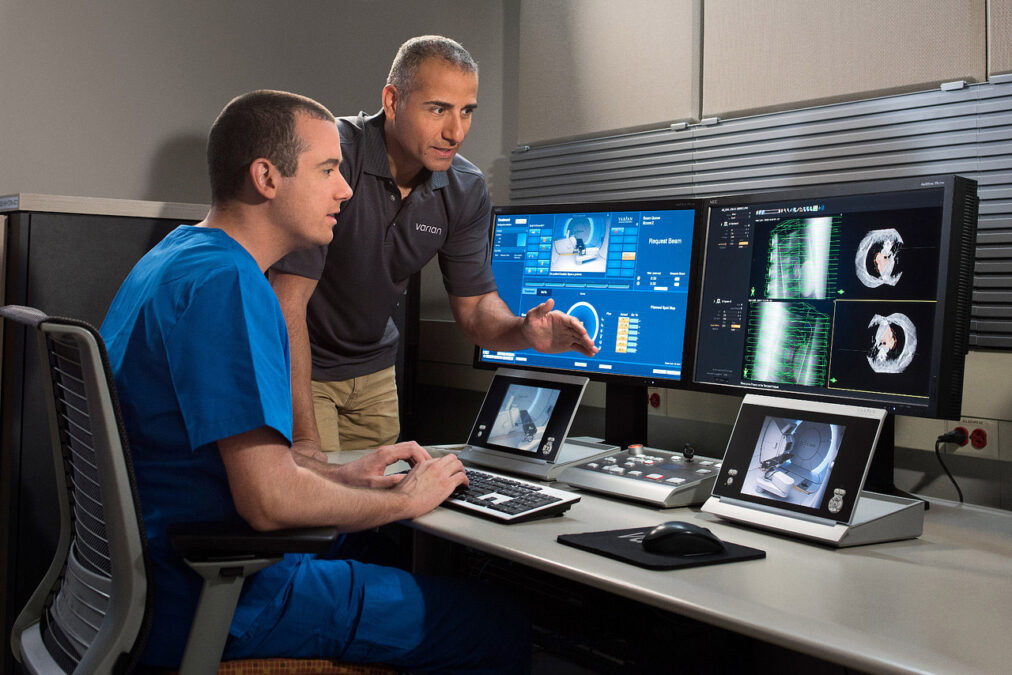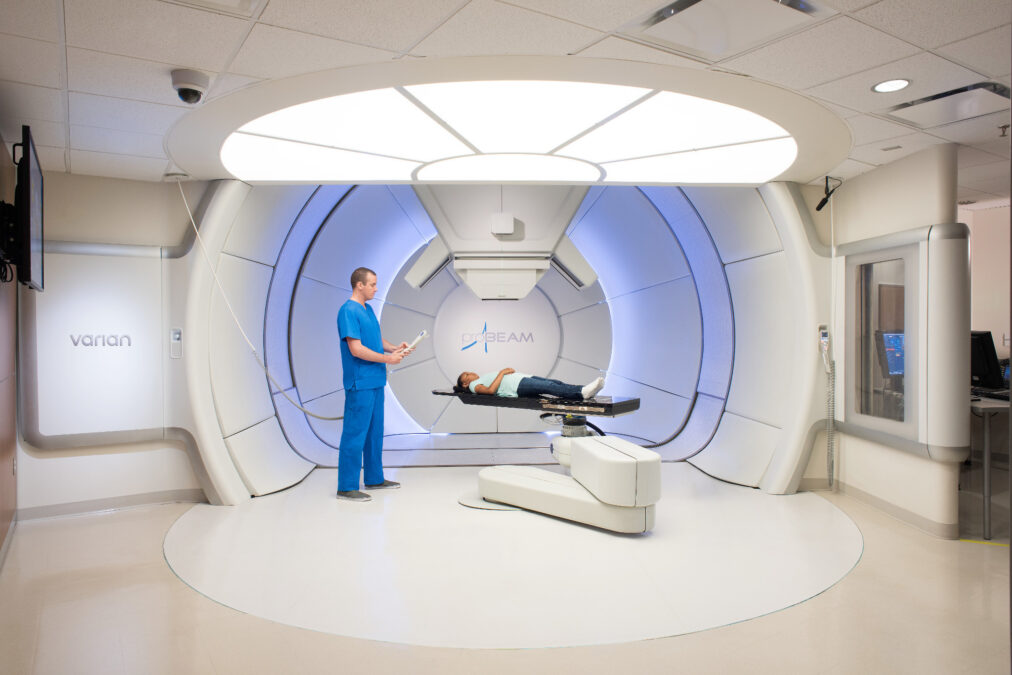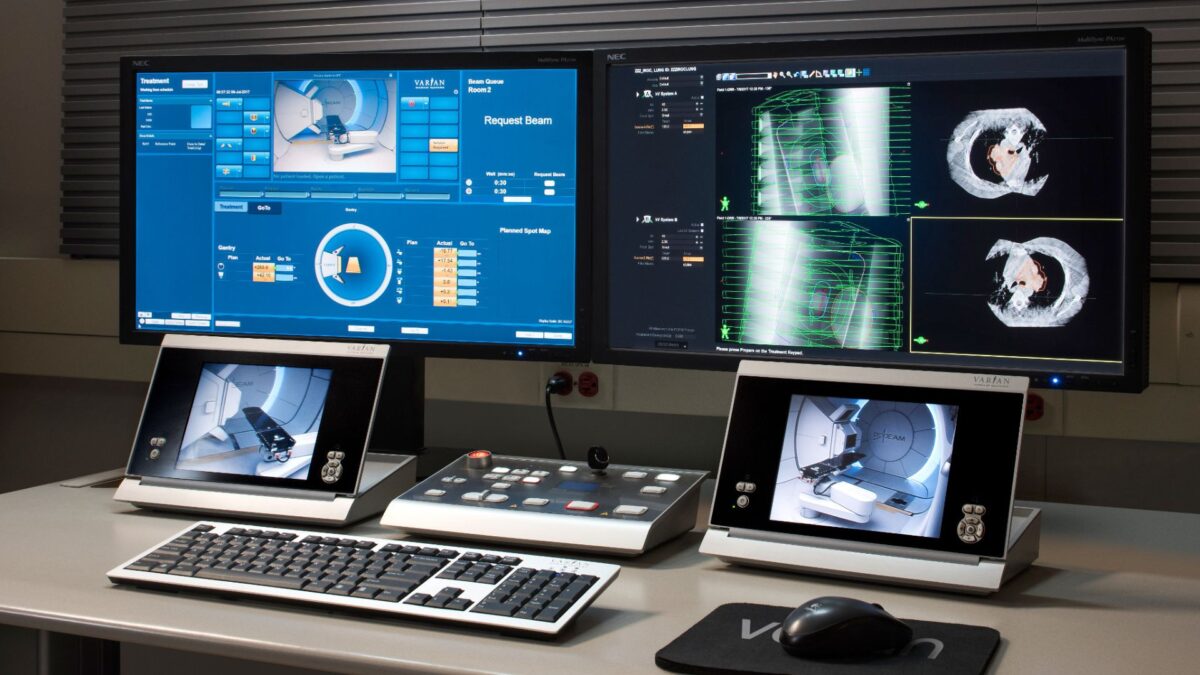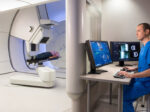In the UK alone, there are around 12,400 new cases of head and neck cancer diagnosed each year. Head and neck cancer is a general term for cancers that occur in the mouth, throat, salivary glands, thyroid gland, larynx (voice box), pharynx, nasal cavity and sinuses.
As with any cancer, early diagnosis is critical and so is using targeted therapies that destroy malignant cells while leaving healthy tissue intact. This is especially important in cancers that are in parts of the body that have critical organs and structures nearby, such as in the head and neck. The critical organs and structures in the head and neck include the spinal cord, the oral cavity (tongue and mouth), salivary glands, the eye and optic nerve, and the brain.
Proton beam therapy, also called particle therapy, is a type of radiotherapy that is very precise in how it delivers dose to the tumour, while also avoiding surrounding critical organs and normal tissue structures. This greater precision compared with photon therapy potentially reduces side effects (acute toxicities) during treatment and after treatment (late toxicities), as it avoids exposing surrounding healthy tissue to unnecessary radiation, particularly beyond the tumour.

With head and neck cancers, it can reduce the risk of patients suffering uncomfortable side effects such as sore mouth and throat, sticky saliva and mouth dryness, and dry eyes.
Proton beam therapy is a next-generation approach to targeted radiation treatment. While it is now an advanced, highly technical form of radiotherapy, it was first seriously considered as a cancer treatment as far back as the late 1940s. Its use for treating cancer has gradually been increasing in recent years, with more proton therapy centres being built around the world.
The early proton beam therapy machines were less precise, using a more spread-out radiation beam technique to deliver the radiotherapy. The current state-of-the-art machines now use the much more precise pencil beam scanning technique, delivering intensity-modulated proton therapy (IMPT), which allows a high level of shaping and conforming of the proton beam to the shape of the tumour. As a result, there has been emerging evidence of its effectiveness as a treatment for head and neck cancer.
While proton beam therapy has been in use around the world for some time, its availability is still limited in many countries. In the UK, it was approved for use by the NHS in 2008, but it wasn’t until 2018 that the Christie Hospital in Manchester began treating patients. In 2021, a second centre was opened at University College London Hospital (UCLH).

Here we look at the role of proton beam therapy in the treatment of head and neck tumours:
Why is proton beam therapy used for head and neck cancers?
Radiotherapy is a highly effective treatment which can cure early-stage cancer and relieve symptoms or prolong survival in more advanced cancers. The challenge for clinicians when treating head and neck cancers with radiotherapy is that tumours require relatively high doses of radiotherapy and are often near to or surrounded by critical organs and structures, which, if damaged by radiation, can cause unpleasant side effects.
One of the key considerations when treating head and neck cancers is to reduce the potential for damage to smell and taste, saliva production, hearing, vision, and the spinal cord.
Proton beam therapy is particularly suited to the treatment of head and neck cancer because of its ability to target treatment precisely while reducing radiation dose to normal tissues.
It allows clinicians to deliver a higher dose to the tumour itself while delivering lower radiation doses to surrounding normal tissues. In turn, this can mean more effective treatment of cancer, reducing the risk of disease recurrence in the future, and also reduced toxicity and improved quality of life for patients with a range of different head and neck cancers.
How is proton beam therapy different to normal radiotherapy?
Traditional radiotherapy uses photons rather than protons, and even if using advanced radiotherapy techniques such as intensity-modulated radiotherapy (IMRT), these photons must enter and exit the body and will leave a certain amount of collateral damage.
Because proton therapy travels into the body and treats the tumour but has no exit dose, this means that normal tissues can be spared from receiving unnecessary radiation, and so it can be of particular benefit for minimising side effects when treating head and neck cancers.

The process for receiving proton beam therapy treatment is very similar to that for radiotherapy. Before they begin treatment, patients will have a planning appointment where they have a CT scan and possibly an MRI scan.
These scans are used by their oncologist and specialist radiotherapists to plan proton beam therapy. Head and neck patients usually have a bespoke mask made, which they will wear during the scan.
A course of radiotherapy is given daily, usually over several weeks, and it is important that the position of the patient is the same each time a treatment is delivered. The mask (sometimes called a shell) keeps the treatment area of the body fixed and still each time and ensures treatment is as accurate as possible.
What head and neck cancers are treated with proton beam therapy?
There are many types of head and neck cancers that may benefit from treatment with proton beam radiotherapy, either on its own or in conjunction with other treatments.
These can include, but aren’t limited to:
- Nasopharyngeal cancer
- Some salivary gland tumours of parotid, sub-mandibular and minor salivary glands
- Throat, tongue or tonsil (oropharyngeal) cancer
- Complex skin cancers or squamous cell carcinoma involving cranial nerves and/or lymph nodes of the neck
- Cancers of the nasal sinuses (sino-nasal/nasal cavity cancers)
More widely spread cancers will normally be approached with several different treatments, including surgery, radiotherapy, chemotherapy and immunotherapy.
Whether proton beam therapy treatment is right for a particular patient is a decision likely to be made through a combination of factors.
In these cases, doctors need to weigh up the added effectiveness of proton beam therapy as a treatment compared with photon radiotherapy, the extent of any cancer and how it will benefit the patient by potentially reducing side effects.
How effective is proton beam therapy for head and neck cancers?
Proton beam therapy has been studied around the world, and its effectiveness has been assessed for a range of different head and neck cancers by looking at outcomes for patients who have already received treatment (retrospective studies).

As more dedicated proton therapy centres open globally, we are seeing an increase in research papers that suggest that it may well be more effective for better local control of tumours and reduced normal tissue toxicity.
A number of clinical trials are currently ongoing that are looking at the benefits of intensity-modulated proton therapy (IMPT) and its potential to reduce toxicity for head and neck cancers.
Some of these are comparing IMPT directly with photon IMRT, such as Cancer Research UK’s TORPEdO trial for oropharyngeal squamous cell carcinoma. The results of these trials are eagerly awaited to provide hard evidence of the benefits of proton beam therapy in head and neck cancers.
The main reason for optimism is that, compared to traditional photon radiotherapy approaches, proton beam therapy is a very promising advance allowing clinicians to potentially deliver more effective radiotherapy doses while reducing the potential for harmful and sometimes life-changing side effects.
While its uses may currently be for a very select group of patients and cancers, proton beam therapy may well be used for a wider range of cancers as we come to develop the technology and see the results of the current clinical trials over the coming years.
How long does proton beam treatment for head and neck cancer take?
The time it takes to treat patients receiving proton beam therapy takes depends on the type of cancer and where exactly it is located, and the exact radiotherapy dose required. Generally, treatment will usually take around 4-6 weeks.
A clinical/radiation oncologist specialising in head and neck cancers will prescribe a total dose of proton beam therapy, this dose is broken down into smaller daily doses called fractions, which are delivered usually for five consecutive days followed by a two-day break at weekends.
Typically, each daily treatment session will last anywhere between 15 and 45 minutes, and a complete appointment is likely to take no more than an hour. This can present logistical challenges for patients and family, friends or carers who don’t live nearby, or even from abroad, but most centres can advise or help arrange accommodation and travel for their patients.
Most patients treated with proton beam therapy tolerate it pretty well and can perform routine activities during and immediately afterwards.
Are there disadvantages to proton beam therapy?
Proton beam therapy is expensive. The price of installing a new machine is in the region of £40 million and the cost of treatment can average out at about £100,000 for a full course of proton beam therapy.
In the UK there are only two locations where patients can be treated on the NHS and between them, they treat around 650 NHS patients each year. For these reasons, proton beam therapy candidates are carefully selected depending on their age, disease profile and history, and the expected benefits of proton beam therapy for them
However, as more clinical evidence of the benefits of proton beam therapy becomes available, more private medical insurers are recognising its value for certain cancers and will cover the cost. It is offered privately to both insured and self-pay patients through Proton International London at UCLH.
In summary
Head and neck cancer presents a unique set of problems for treatment because of the relatively high doses of radiotherapy needed to treat tumours effectively, and the close proximity of a variety of sensitive structures and organs that are at risk of acute and late radiation toxicity.
Being able to closely target tumours and spare critical organs and normal tissue structures is essential for good clinical outcomes and to improve a patient’s quality of life during and after treatment. Proton beam therapy offers the potential for more effective treatment of tumours while reducing the risk of collateral damage to normal tissue structures.

There is a mix of both private and NHS-funded proton therapy treatment available in the UK: The Christie Hospital in Manchester treats NHS patients, and UCLH offers treatment to both NHS and private patients, through Proton International London.
If you would like to find out more, speak to our helpful and friendly team.

This article has been clinically reviewed by Proton International Medical Director and Consultant Clinical Oncologist, Dr Beatrice Seddon. Dr Seddon specialises in the use of radiotherapy (including proton beam therapy) and chemotherapy for the management of soft tissue and bone sarcomas.





